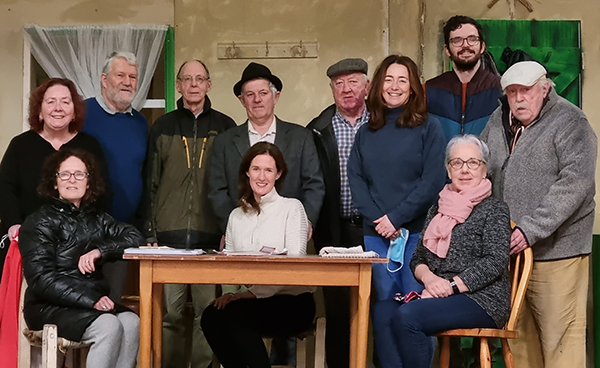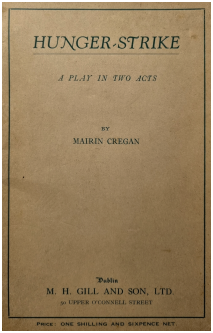MÁIRÍN CREGAN’S HUNGER STRIKE
Published in Issue 2 (March/April 2022), Reviews, Volume 30By Fiona Brennan
The reappraisal of women’s participation in, and contribution to, the revolutionary period is one of the more enduring legacies of the ‘decade of centenaries’ commemorative programme. In the case of Máirín Cregan, Cumann na mBan activist, it has resulted in a reassessment of her literary career and her work as a dramatist. Her two-act play Hunger Strike provides a valuable interpretation of society during the Civil War from a female perspective. Its dramatic plot is inspired by her real-life experiences as a young wife and mother, as her husband, James Ryan, went on hunger strike during the autumn of 1923 while interned at the Curragh Camp.

Above: Máirín Cregan and James Ryan around the time of their marriage in 1919. James went on hunger strike in the autumn of 1923 while interned at the Curragh Camp, providing the inspiration for Máirín’s play Hunger Strike. (UCD Archives)
Máirín was born in Killorglin, Co. Kerry, on 27 March 1891, and her family espoused fervent support for the Gaelic revivalist movement. During her summer holidays she sought Irish-language tuition from her teacher, Una Nic Coluim, a prominent member of Killorglin Cumann na mBan. Upon leaving school, she worked for a time as a teacher before moving to Dublin in 1914 to study at the Leinster School of Music. There she became a committed member of the Gaelic League and, alongside other young nationalists, socialised at the Dublin home of the prominent nationalist family the Ryans of Tomcoole, Co. Wexford. Máirín became friends with the Ryan sisters, Min, Kit and Phyllis, and their brother James, a medical officer in the GPO during the Rising, whom she would eventually marry.
In 1916 Máirín assisted during Easter Week actions. On Holy Thursday she travelled by train to Tralee with ammunition hidden in her violin case. She also carried written instructions for Austin Stack on how to operate the wireless technology used to contact the Aud, which was due to dock at Fenit Harbour with a shipment of arms on board. Having successfully completed her mission as instructed, Cregan travelled to Killorglin on Good Friday, only to learn of the drownings of three volunteers at Ballykissane Pier, just outside the town.
James and Máirín married in July 1919, some six months after his election to the First Dáil. They lived in County Wexford for the duration of the War of Independence and their home was frequently raided by Crown forces. Undeterred, Máirín worked as a courier for Robert O’Brennan in the Department of Foreign Affairs. In 1925 they settled with their children, Nuala, Eoin and Seamus, at Kindlestown House, Delgany, Co. Wicklow. As a founder member of Fianna Fáil, James went on to enjoy a prestigious political career, serving as minister in various departments until his retirement in 1965.
Cregan’s first children’s novel, Old John, was published in 1936 and its Irish translation was included on the national school curriculum. Her second novel, Rathina, won Cregan international acclaim, including the prestigious Downey Award for Children’s Fiction (USA) in 1942, and was translated into several languages. Cregan had begun playwriting some years previously, having completed Hunger Strike by 1929. She continued to write drama, including a one-act play, Curlew’s Call (published 1940), on the theme of emigration, as well as radio adaptations of children’s and adult fiction. Later, she drafted an experimental, fantastical drama for television.
Hunger Strike is not unique in terms of its political themes. Apart from O’Casey’s The Plough and the Stars, less-familiar dramas include A.P. Fanning’s Vigil (Abbey Theatre, 1932) and, later, Bryan MacMahon’s The Bugle and the Blood (Abbey Theatre, 1948). There are also numerous examples of original, revolutionary-themed plays and pageants being written by members of amateur groups and performed locally.

Above: Members of Killorglin Archive Society, who will perform Máirín Cregan’s Hunger Strike at 8pm on 24–26 March and 31 March–2 April 2022 in the CYMS Hall, Killorglin, Co. Kerry. Seated from left: Mary Gallagher (co-director), Susan McCarthy (Nano Grady), Kathleen Cronin (Mrs Moriarty); standing from left: Madeline Foley (Aunt Julia), John O’Connor (chairperson), Stephen Thompson (secretary), Gene Ahern (Davy), Eamon Crowley (Darkey), Claire Conway (Maney), Brian Ahern (Pasha), Noel Shanahan (co-director); missing from photo: Gearóid Clifford (Willie).
Booking: killorglinarchivesociety@gmail.com
Hunger Strike is set in County Kerry and the play’s protagonist is one Nano Grady. As the play opens, her husband Ned has been on hunger strike in an unnamed Dublin prison for 25 days. The play’s basic structure relies on the exchange of letters between Nano and Ned, which is inspired by the Ryans’ actual correspondence during 1922 and 1923. Dramatic themes encompass familial tensions regarding the overtly political divisions of the time. Her aunt, Julia Sullivan, and Nano’s brother, Willie, are pro-Treaty and are insistent that Nano write to Ned and implore him to end his strike. Its themes include the imposition of traditional social mores on women. As Julia epitomises the traditionalists’ stance, she detests Nano’s independence and self-determination. She blames everything on Nano’s foolishness in ‘joining the Cumann na mBan’ and the fact that she completed third-level education.
 The action elucidates the historical realities of the strikers’ lofty moral objectives versus the ominous consequences of their actions for their wives and children. Bravely, the play focuses on the Catholic Church’s condemnation of political hunger strikes as suicide. Ned writes: ‘The priests accuse us of suicide, the doctors tell us we may die any minute, our hearts being weak’. Julia’s tactics become more vicious and she torments Nano by vividly describing Ned’s physical and psychological deterioration. Nano remains steadfast in her support for Ned’s actions, declaring that, despite the repercussions, she prefers ‘to see his dying made as easy as possible for him’. Nano takes strength from the faith and support of her neighbours—the wise old Fenian, Davy, who has long since lost all religiosity, and the elderly Mrs Moriarty, who has remained devoutly religious despite the acts of political retribution against her sons that resulted in their deaths. Nano’s subtle ally in her female servant, Maney, is a touching aspect of the play’s development throughout. At the drama’s denouement, a telegram arrives with news that Ned and the men have triumphed. Nano collapses as she reads that the strike is officially over.
The action elucidates the historical realities of the strikers’ lofty moral objectives versus the ominous consequences of their actions for their wives and children. Bravely, the play focuses on the Catholic Church’s condemnation of political hunger strikes as suicide. Ned writes: ‘The priests accuse us of suicide, the doctors tell us we may die any minute, our hearts being weak’. Julia’s tactics become more vicious and she torments Nano by vividly describing Ned’s physical and psychological deterioration. Nano remains steadfast in her support for Ned’s actions, declaring that, despite the repercussions, she prefers ‘to see his dying made as easy as possible for him’. Nano takes strength from the faith and support of her neighbours—the wise old Fenian, Davy, who has long since lost all religiosity, and the elderly Mrs Moriarty, who has remained devoutly religious despite the acts of political retribution against her sons that resulted in their deaths. Nano’s subtle ally in her female servant, Maney, is a touching aspect of the play’s development throughout. At the drama’s denouement, a telegram arrives with news that Ned and the men have triumphed. Nano collapses as she reads that the strike is officially over.
The play took Cregan twelve months to complete. She later confirmed that her primary objective in writing it was to ensure that American audiences had an accurate account of the hunger strikes. On its publication by M.H. Gill and Sons Ltd in 1933, Hunger Strike was lauded by critics. A writer in the Kerryman newspaper described the play as having ‘embraced all the patriot suffering of Irish womanhood’ and being ‘remarkably free of bitterness’. In the Derry Journal, Cregan was described as a ‘pioneer’ amongst playwrights.
By that time the play had already been rejected by the Abbey Theatre for lacking, apparently, the all-important ‘immediate appeal’ for audiences. Unsurprisingly, the Abbey directors were mindful of the religious and political controversies that the play would have surely provoked had it been produced. As Patrick Keohane, Cregan’s editor, surmised, ‘it is too true … we are too close up to the realities as well, in every sense of the word’.
In August 1933 Paul Vincent Carroll, one of Ireland’s most prestigious writers at the time, sought to option its production. Likewise, the film-maker and playwright Mary Manning applied for the performance rights on behalf of the Irish Women Workers’ Union’s Dramatic Society. Cregan refused her permission, however, and the play remained unproduced. It was eventually adapted for radio by 2RN in 1936. Following its broadcast that May, Cregan received a letter from Tomas Ó Maoláin, which concluded: ‘My father … who went through all the (similar) torture of mind … was very much affected by the realism of the production’.
Fiona Brennan is a theatre historian and archivist.
















